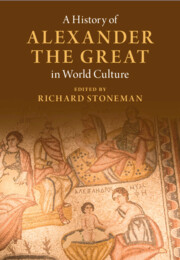Book contents
- A History of Alexander the Great in World Culture
- A History of Alexander the Great in World Culture
- Copyright page
- Contents
- Figures
- Notes on Contributors
- Preface
- Abbreviations
- 1 Introduction
- 2 Alexander and Alexandria in Life and Legend
- 3 The Image of Alexander in Ancient Art
- 4 Alexander, Philosophy and Rome
- 5 Christianising Alexander Traditions in Late Antiquity
- 6 Alexander in Ancient Jewish Literature
- 7 The Medieval Alexander
- 8 Alexander the Great and the Crusades
- 9 The Slavic Alexander
- 10 Alexander the Great in Byzantine Tradition, AD 330–1453
- 11 The Spanish Alexander
- 12 The Persian Alexander (1)
- 13 The Persian Alexander (2)
- 14 Alexander in Medieval Arab Minds
- 15 Alexander in the Age of Shakespeare
- 16 Alexander the Great in Opera
- 17 Alexander in the Long Eighteenth Century (c.1660–1830)
- 18 Images of Alexander in Germany
- 19 Alexander the Gay and the Gloryhole That Was Greece
- Index
- References
2 - Alexander and Alexandria in Life and Legend
Published online by Cambridge University Press: 13 January 2022
- A History of Alexander the Great in World Culture
- A History of Alexander the Great in World Culture
- Copyright page
- Contents
- Figures
- Notes on Contributors
- Preface
- Abbreviations
- 1 Introduction
- 2 Alexander and Alexandria in Life and Legend
- 3 The Image of Alexander in Ancient Art
- 4 Alexander, Philosophy and Rome
- 5 Christianising Alexander Traditions in Late Antiquity
- 6 Alexander in Ancient Jewish Literature
- 7 The Medieval Alexander
- 8 Alexander the Great and the Crusades
- 9 The Slavic Alexander
- 10 Alexander the Great in Byzantine Tradition, AD 330–1453
- 11 The Spanish Alexander
- 12 The Persian Alexander (1)
- 13 The Persian Alexander (2)
- 14 Alexander in Medieval Arab Minds
- 15 Alexander in the Age of Shakespeare
- 16 Alexander the Great in Opera
- 17 Alexander in the Long Eighteenth Century (c.1660–1830)
- 18 Images of Alexander in Germany
- 19 Alexander the Gay and the Gloryhole That Was Greece
- Index
- References
Summary
This chapter is concerned with Alexander in Egypt in both life and legend. Subjects discussed include his foundation of Alexandria, which became a new capital for Egypt on the Mediterranean coast, his expedition through the Libyan desert to Siwah, where the oracle’s recognition of the conqueror as son of Zeus-Ammon resonated in both Greek and Egyptian cultic terms, his acceptance as the pharaoh of Egypt, and finally, after his death in Babylon, his return for burial to Egypt, where his embalmed corpse and tomb in Alexandria became the centre of Ptolemaic ruler cult, a focal point for later visits of Roman emperors, and where the question of its actual location remains a source of continuing fascination and debate. In the accounts of classical historians, Alexander in Egypt is already variously presented; the historiography is as important as the history. From the start some specifically local legendary elements may be seen and over time the Romance or Legend of Alexander in its many different forms overshadows and surpasses any strictly historical account.
- Type
- Chapter
- Information
- A History of Alexander the Great in World Culture , pp. 14 - 41Publisher: Cambridge University PressPrint publication year: 2022
References
- 1
- Cited by

